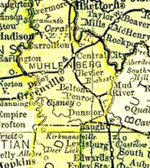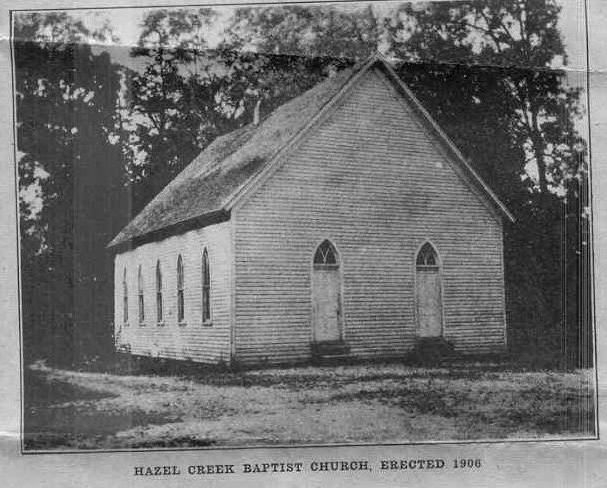Muhlenberg County Kentucky

Churches
Life in the Olden Days: Hazel Creek, Mt. Oliver & the Great Revival
Hazel Creek Baptist Church was organized December 3, 1798, and was the first church organized in the county. This is not only the first but also the oldest church organization in Muhlenberg. Futhermore, it is the only church in the county of which a history has been published. In 1898 Professor William J. Johnson, who then lived near Wells, printed a seventy-page pamphlet entitled “History of Hazel Creek Baptist Church.” This church, like many of the other early churches, became the mother of other organizations. Relative to the twelve churches originating from Hazel Creek, Professor Johnson says:
“In 1799, twelve members were authorized ‘to continue an arm at George Clark's, on the west side of Pond Creek,’ which doubtless led to the formation of Nelson Creek church, June 10, 1803. June 1, 1805, eighteen members were dismissed from Hazel Creek church to form Midway church, now Monticello. August 2, 1806, eighteen members were dismissed to form what is now Cave Spring, near Pond river, on the road from Greenville to Hopkinsville. Cypress church, McLean county, was formed from this church in 1808. Antioch, Todd county, was formed from this church, and also Whippoorwill church in the year 1819. May 6, 1820, the arm known as Hebron (now Mt. Vernon) was made a constituted body. In 1840, thirteen members from this church formed new Hebron church (Muhlenberg). Ebenezer was organized with twenty-six members from this church, January 3, 1851. Macedonia was formed from this church on November 22, 1856. New Hope church (Muhlenberg) was formed of material mostly from this church, in 1858; but is now extinct. Sugar Grove was constituted with twenty-five members, mostly from this church, in January, 1873.”

It may be well to add that the Hazel Creek congregation built its first house in 1800, its second in 1807, and its third in 1857, all of which were of logs. Its fourth (the present) building was erected in 1906.
Mount Olivet (three miles northeast of Central City) is probably the oldest Methodist church in Muhlenberg. Mount Zion (one mile east of Central City) is among the oldest Presbyterian organizations. Although Mount Zion was organized as early as about 1802, the congregation, it is said, did not erect its first house until about twenty years later. As a rule, the church houses built by the pioneers were union chcurches - that is, buildings erected jointly by two or more denominations, who conducted their services independently of one another. In Greenville, up to about 1825, the academy building served the purposes of a school and a union church. As far as I have been able to ascertain, the Presbyterians of Greenville were the first in that town to erect a building of their own. I tried to procure data relative to the early history of all the old churches in the county, but an investigation showed that in only a few cases had the old church records been preserved.
In religion, as well as in politics and business, the pionners of Muhlenberg were always conservative. The “Great Revival” of the first part of the last century, that spasmodically stirred what was then called the West, did not throw many of the people of Muhlenberg into “jerks” and other mysterious “exercises.” In Kentucky its effect was felt more in the southern and central sections of the State.
This “Great Revival” began in Logan County in 1799, under the ministry of John McGee, of the Methodist church, and his brother William McGee,of the Presbyterian, and soon spread over the State. Tradition says that the local men and women who had gone to Logan and Christian counties to attend these great camp-meetings were the only ones affected by the “exercises.”
Reverend Barton W. Stone (who married Elizabeth Campbell, daughter of Colonel William Campbell) in his “Autobiography,” published in 1844, says that while at Greenville in July, 1801, he heard of the wonderful things taking place at some of the revivals in other sections of Kentucky. He and his wife “hurried from Muhlenberg” immediately after they were married, and went to Cane Ridge, Bourbon County, to see and study the extraordinary phenomena. His description of the “bodily agitations” is the best that has been written. Had any of these “exercises” taken place in Muhlenberg he in all probability would have stated the fact in his book.
Peter Cartwright in his “Autobiography,” published in 1856, also gives an interesting account of these revivals, but refers to Muhlenberg only once. Commenting on the widespread effect of one of his great camp-meetings held some time during the year 1812, while he was riding the “Christian circuit,” so named after Christian County, he says (page 122): “From this meeting a revival spread almost through the entire country round, and great additions were made to the Methodist church. This circuit was large, embracing parts of Logan, Muhlenberg, Butler, Christian and Caldwell counties in Kentucky and parts of Montgomery, Dixon and Stewart counties in Tennessee.”
It is more than probably that Peter Cartwright conducted a number of meetings in Muhlenberg. Tradition, however, tells of only one place where he did so - the Old Camp Groud, located north of Cleaton and near the Greenville and Seralvo [Ceralvo] Road. Tradition has it that he preached there not only once but often, and that all his meetings were well attended. One of Peter Cartwright's personal friends and disciples in Muhlenberg was Reverend Silas Drake, one of the best-known local Methodist preachers and circuit riders, and of whom the following characteristic incident is related:
Preacher Drake was opposed to the wearing of things that were more ornamental than useful, declaring that such apparel was indicative of pride, and that “ear bobs are the devil's stirrups.” One day, while addressing a crowd at an arbor meeting, he observed a woman with large bows of ribbon on her bonnet. He called her by name, reproved her, and told her that such bows were of absolutely no use. She, without hesitating, retaliated by saying, “Neither are the buttons on your coat sleeves or on the back of your coat!” He immediately pulled off his coat, cut off the buttons referred to and never afterward wore a coat with buttons sewed on the sleeves or back.
Reverend Silas Drake was a son of pioneer Albritton Drake, a Revolutionary soldier who settled in southern Muhlenberg in 1806, where he died in 1834. Albritton Drake married Ruth Collins, They, as already stated, were the parents of Reverend Silas, Mosley Collins, Reverend Benjamin, J. Perry, Edmond, and William. Reverend Silas, Mosley Collins, and Edmund Drake married daughters of pioneer Micajah Wells. Reverend Silas Drake was born in 1790 and married Patsy Wells; he preached for a half century, and in the meantime farmed in the Long Creek country, where he died in 1858. J. Perry Drake married Priscilla Buell, who was a sister of General Don Carlos Buell's father. The parents of General Buell died while he was still a child, and the rearing and educating of young Buell was assumed by his uncle and aunt, Mr. and Mrs. J. Perry Drake, who were then living in Indianapolis. J. Perry Drake was a Mexican War soldier and a well-known Indiana lawyer. One of his daughters, Elmire Drake, became the wife of General W.T.H. Brooks of the Federal army.
No matter whether affected permanently, temporarily, or not at all by the “Great Revival” or any other revivals, all of the early settlers exercised more or less influence over their contemporaries and descendants. However, it is an indisputable fact that many, if not most, of the good influences exerted by the early settlers were due directly or indirectly to the work of the women of the community. Written records as well as local traditions fail to give the women who lived in the olden days the credit they deserve for their moral and religious influence. They always showed courage on trying occasions. They were the doctors of the times, and in some instances the sole preservers of hard-earned homes or farms.
Source: Rothert, Otto A. “Life in the Olden Days.” A History of Muhlenberg County. Louisville, KY: John P. Morton, 1913. 128-130. Reprinted in Times-Argus [Central City, KY], Oct 1969.
Contributed by Joe Taylor
Updated July 24, 2022